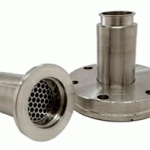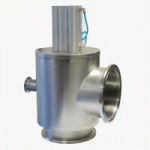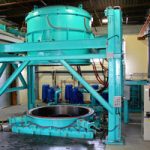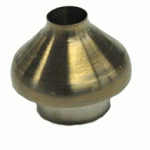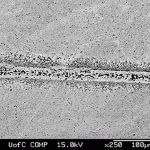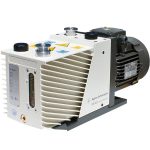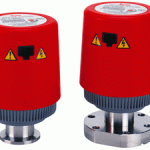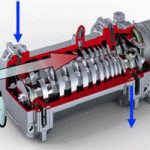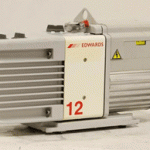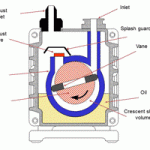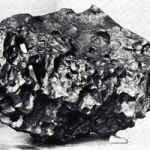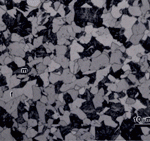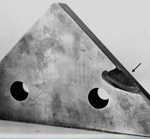Vacuum Heat Treating: Education & Training
Vacuum Gauges
A Vacuum Gauge is a pressure measuring instrument that measures pressure in a vacuum (i.e., in a vessel operating at sub-atmospheric pressure). Depending on the type of vacuum system (Fig. 1) and the required operating vacuum level, different vacuum gauges[...]
Vacuum Valves – Types and Operation
Vacuum valves are an essential component in any vacuum system. There are a variety of different types that fall into three main categories – operational valves, closing valves and sealing valves (Fig. 1). The selection of the proper valve type[...]
Vacuum Furnace Safety
When problems arise, especially those related to safety, we want to know that we have isolated the root cause and instituted corrective action measures so as to avoid their reoccurrence.
Worker safety and the safe operation of heat-treat equipment is both[...]
Vertical Oil Quench Vacuum Furnace Overview
We continue our discussion about vertical vacuum furnaces by focusing on designs utilizing an oil quench tank.
Vertical Oil Quench Vacuum Furnaces
A typical vertical oil quench vacuum furnace (Table 1) either utilizes a heating chamber mounted atop a movable gantry so[...]
Vacuum Technology with The Heat Treat Doctor
Discolored Work in a Vacuum Furnace – The Heat Treat Community Answers the Clarion Call
For those of us who participate in the Heat Treatment group of LinkedIn (https://www.linkedin.com/groups/1855932), which by the way is 8795 members strong (!), an important vacuum processing question was recently asked and what follows is a stimulating exchange of ideas,[...]
Vacuum Diffusion Bonding – by Design
Many of us who use vacuum furnaces are all too familiar with and have learned how to counteract the unintentional diffusion bonding that has been known to occur between component parts exposed to high temperatures and low vacuum levels.1
By contrast,[...]
Evaporation
When performing any type of vacuum heat treatment it is always important to be aware of the possibility of evaporation and/or sublimation of elements, which can be present in the material being processed, introduced into the vacuum system with the[...]
Vacuum Deposition Processes
Vacuum deposition is a generic term used to describe a type of surface engineering treatment used to deposit layers of material onto a substrate. The types of coatings include metals (e.g., cadmium, chromium, copper, nickel, titanium) and nonmetals (e.g., ceramic[...]
A Layman’s Guide to Understanding The Theory of Gases
The movement of gases is an important and interesting subject but one often dismissed as a topic best left to scientists. However, the Heat Treater needs to know something about the basic nature (theory) of gases and in particular how[...]
Vacuum Brazing with Dan Kay
No posts available
Vacuum Pump Technology: Education and Training
Oil Sealed Rotary Vane Pumps
Oil sealed rotary vane pumps (aka rotary vane pumps) are the primary pumps on most vacuum systems used in the heat treatment industry. They are also referred to as a "backing" pump when used in combination with a booster pump,[...]
Proper Selection and Use of Vacuum Gauges
Selecting the correct vacuum gauge or gauges is critical to the success of a heat treatment process. It is important to know how they work and what options are available so that the correct choice can be made. There are[...]
Dry Pumps: Screw Type
Dry pumps are becoming increasingly popular as an alternative to oil sealed rotary vane pumps for many medium and high vacuum applications (e.g., in low-pressure vacuum carburizing where fine granular soot is carried from the process into the pump). Designers[...]
The Rotary Vane (RV) Vacuum Pump
The Edwards “RV” (simply meaning Rotary Vane) laboratory sized oil-sealed rotary vane vacuum pumps (Fig. 1) have been in the market since 1993. They have a very unique design with no equal. This article will attempt to show the reasons[...]
The Oil Sealed Rotary Vane Vacuum Pump - Background and Designs
Vee belt drive design
This article discusses one and two-stage “medium vacuum” oil sealed rotary vane vacuum pumps that can produce a catalog ultimate vacuum of about 1 x 10-2 Torr (0.01 Torr or 10 microns) for a one stage model[...]
Metallography with George Vander Voort
Metallography of Iron-Nickel Meteorites
Abstract
Meteorites have fascinated mankind for centuries. Indeed, more than two dozen meteorites have been venerated by Indian tribes, aborigines, Arabs and other ancient peoples. The study of meteorites is part of the overall study of the origin of our solar[...]
Microstructure of Isothermally-Treated Steels
Introduction
The microstructure of iron-based alloys is very complicated, being influenced by composition, homogeneity, processing and section size. Microstructures in coarse-grained steels are much easier to observe than in fine-grained steels. Of course, steels are normally made with a fine grain[...]
Conducting the Failure Examination
Failures in metallic components may be caused by any of the following factors or combinations of factors:
Design shortcomings
Imperfections due to faulty processing or fabrication
Overloading and other service abuses
Improper maintenance and repair
Environmental factors
Not all failures are[...]
Identifying the Cause of Tool and Die Failure
Abstract
Tool Steel Failure Examples and Metallographic Imagery below.
Steels used for tools and dies differ from most other steels in several aspects. First, they are used in the manufacture of other products by a variety of forming processes. Second, tools and[...]
Metallographic Examination of Medical Implants
Abstract
Medical technology has developed many new devices that can be implanted into humans (in-vivo) to repair, assist or take the place of diseased or defective bones, arteries and even organs. The materials used for these devices have evolved steadily over[...]





